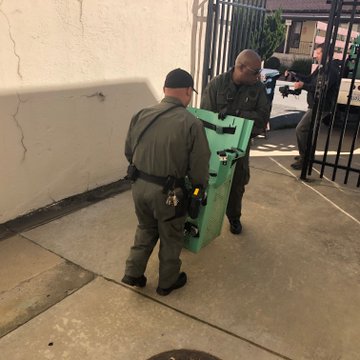
An image of the lethal injection chamber used in San Quentin prison. Following Governor Gavin Newsom’s announcement on Wednesday, crews emptied the room (Below). (Image courtesy Wikimedia Commons)
March 14, 2019 - By John Hickey - Both in 2012 and 2016, Californians cast their votes in favor — by extremely narrowly margins in ballot initiatives — of having the state retain the death penalty.
So on Wednesday, when Gov. Gavin Newsom put a moratorium on California’s use of the death penalty, he not only spared the lives of 737 men and women facing execution by the state, he stirred up a hornet’s nest of praise and invective.
For Elisabeth Semel, a UC Berkeley law professor and director of the Berkeley Law Death Penalty Clinic, much of the verbiage being thrown around to attack Newsom’s move is missing the point. The governor hasn’t overturned the vote, she says, and couldn’t if he wanted to.
“First of all, as governor, he has the absolute power to grant reprieves,” Semel says. “It’s in the constitution and not debatable. He hasn’t abolished the death penalty. But he is seeing where we take this as a state. The votes in 2012 and 2016 were (in favor of the death penalty) by a hair. This is a state that is divided on the issue 50-50.
“I believe that opposition to the death penalty is stronger than the result would indicate. We all know California ballot initiatives are highly complicated and a function of money. They aren’t a pure reflection of opinion. And it’s also a function of leadership. If the governor is out there supporting an initiative, that can make a big impact.”
California hasn’t executed anyone in 13 years, since 2006. And from 1978 to 2002, the state didn’t have any executions. In between, the state used its execution authority 13 times. Newsom has long been a proponent of getting rid of the death penalty, and he was facing a death row where 25 individuals had exhausted their appeals and whose names could come across his desk in the near future.
Those 25, and those of the other 712 on death row, have not escaped execution, Semel says. It’s just that, as long as Newsom is governor, they will not be put to death. Nationally, it’s a big story, because California is home to about one-quarter of all residents of death row.
“This will not change the status of any of these people,” Semel says. “They are still on death row. And while there are 25 who have had the traditional rounds of review exhausted, it’s also true that, for any of them, there still could be a development that will allow them to go back to court.
“Newsom sees these 25 at risk, and he’s taken that off the table for as long as he’s governor. He has a broader vision for where he would like this to go. For now, he’s working within the limits of his authority as governor.”
California becomes the fourth state to have a current moratorium on executions, joining Oregon, Colorado and Pennsylvania. There are 20 states, plus the District of Columbia, that have banned the death penalty outright.
That’s not something Newsom has done with his executive order. Nor could he.
“Clearing death row is something some governors have the ability to do,” Semel says. “Not in California.”
Semel and the clinic she’s directed since 2001 offer pro bono representation to those facing the death penalty. Occasionally, the Death Penalty Clinic will be with a case from the start, but the bulk of its work is in post-conviction review.
“We represent some clients in California,” she says. “But mostly we represent people in states like Texas, Alabama and Georgia.”
According to statistics compiled by the nonprofit Death Penalty Information Center, those three states held a combined 46 executions from 2016 to 2018.
“We are training lawyers to handle cases like these,” Semel says. “These are difficult, complicated cases, and you don’t always represent popular clients. We frequently represent poor clients. They have plenty of issues, but they often were very poorly represented while on trial.”
She says Newsom’s move Wednesday is likely to spark a heated conversation about the death penalty. It’s a conversation that the anti-death penalty community welcomes.
“I think, based on what he said today, that this is the first step on a longer journey,” Semel says. “That’s one reason he emphasized so heavily the failings of the process. He wanted that highlighted, so that we could have a pragmatic and profound conversation.”
It may be difficult to have that kind of conversation immediately. Death penalty advocates seem to believe that after the razor-thin approval in 2016 of Proposition 66, the Death Penalty Procedures Initiative, California would get back to executions after 13 years away.
“They are furious because they thought they were getting close to being able to get on with it,” Semel says. “It’s problematic. There were two measures on the ballots, and they were unbelievably confusing to the voters.”
Semel says that the voters haven’t had to deal with the realities of the death penalty because of the 13 years that have passed since the last one in California.
“California is more accustomed to having no executions than to having some,” she says. “The governor was going to be confronted with a bunch of executions, and California has never seen anything like it.
“It’s easy not to think about it, even when we are paying through the nose for it. Day to day, we haven’t had to think about it. That would change if those executions took place.”
And the conversation may change now that they won’t take place.
“California should pay attention to the whole of what the governor said today,” Semel says. “He covered a lot of territory about his motivations. His reflections and this thoughtfulness about the importance of the decision are worth talking about.”
Source: UC Berkeley

